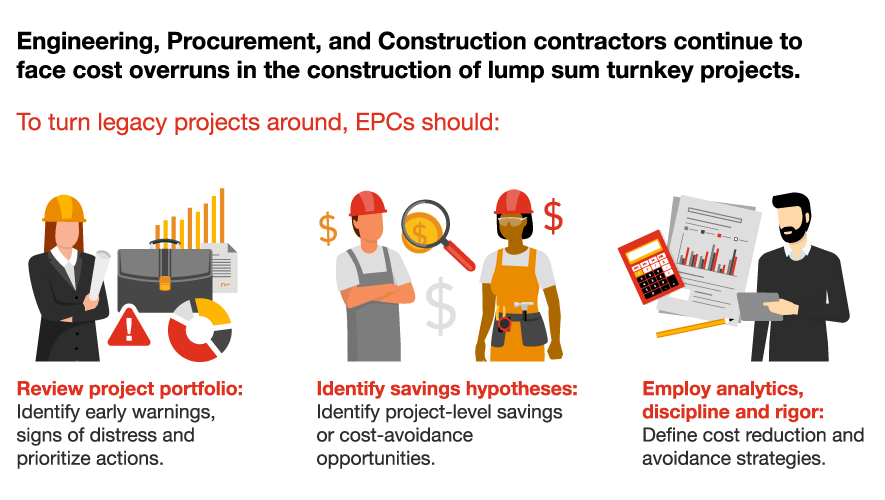Buck the trend: Project intervention and profitability
There have been many studies, surveys and articles putting forth the large percentage of mega construction projects that “fail,” are late, over budget or behind schedule. There are often several causes that contribute to project failures. However, absent a time-machine to go back and remove optimism bias in the pursuit stage, price in additional risks, and correct any estimate busts in their bid price, contractors need playbooks and strategies for turning around troubled projects so they can live to fight another day.
Cost overruns on lump sum turnkey (LSTK) projects continue to challenge Engineering, Procurement, and Construction (EPC) contractors. Repeated disappointments for shareholders in quarterly results are driving improvements in both bidding processes and project delivery, by necessity. Similar trends in the upstream oil and gas segment drove US onshore exploration and production companies to employ capital efficiency measures as a means of survival. We are now observing such efforts taking place within EPC firms, who are adopting improvement strategies aimed at balancing profitable growth, enhanced contracting risk management enabled by digital initiatives and austerity measures, all at the same time.

Selectivity: Adjusting project bids to reduce risk exposure
The balancing of risk between the customer and the EPC contractor is one of the main levers impacting competitive as-bid prices. When contract terms are not in place to address uncertainty in duration and cost, there is a fundamental risk imbalance created by fixed-price agreements. Each additional level of uncertainty placed upon the contractor should and does come at a price. This is felt most acutely on LSTK projects. However, identifying and quantifying risks has become increasingly difficult during the early development stages of recent projects for a few key reasons:
- The size and complexity of some facilities continue to grow, with new entrants and JV alliances competing for footprint in new markets
- Once labor productivity degradation sets in, it is very difficult to correct due to both the number and geographic concentration of these projects, resulting in more competition for skilled labor
- Industry consolidation has resulted in a limited field of EPC competitors who have the capabilities, track record or risk appetite for pursuing complex LSTK projects
- While large EPC firms are still taking on lump sum turnkey projects, their vendors and suppliers are not always aligned with the same back-to-back contract and pricing strategy, and often benefit from losses incurred by the prime / lead EPC contractor
Some EPC contractors, who have experienced these market trends firsthand, are adopting enhanced pursuit and bid approval processes that emphasize project selectivity over backlog and revenue growth – in some cases avoiding fixed price contracts altogether. Further, publicly traded EPC companies and privately held EPC firms have very different governance models and risk thresholds for bid selection, discretionary spend, and entering into joint-venture partnerships, each of which need to be realigned for accountability, transparency and discipline, from the C-suite to Project Directors.
Building a culture of transparency and collaboration
Starting with a lump sum turnkey contract agreement in mind tends to lead to a “closed book” bid and an arms-length relationship between the EPC firm and the customer. This approach has been found to be counterproductive in many cases. Instead, early partnerships between the end customers or asset owners and the EPC contractors during project development will often improve the price discovery process, increase transparency, and enable the willingness to share risks and opportunities on both sides. This approach is especially impactful when projects start construction with unknowns remaining, and customers prioritize speed in getting their facility operating and their product to market.
EPC firms can also improve risk sharing by partnering with peers who have complementary capabilities and customer relationships. Additionally, working with a peer on a lump sum turnkey project should facilitate the sharing of lessons learned from each other’s collective past projects, the adoption of leading industry practices, as well as aid in upskilling the workforce. Some pitfalls to avoid are:
- The duplication of roles or oversight layers
- Redundant systems and applications
- A race to mediocrity when the less rigorous processes and skill expectations of each firm become the norm for the project
- Lack of consistency with regard to financial performance between the parent company and the subsidiary level when partnerships contract to their constituent business units for materials or services.
Establishing mutual goals and cross functional KPIs with incentives may enhance performance monitoring within such partnerships.

Addressing project delivery
Improving the ability to accurately profile a risky project prior to bidding may help avoid unprofitable growth. Pursuing those risky projects with risk-adjusted commercial terms can result in a healthier portfolio of projects to drive profitable growth, even if legacy fixed price projects continue to drag margins down for years. Once a project is through design, and well into construction with committed contracts to equipment manufacturers, subcontractors and material suppliers, there are fewer opportunities for cost optimization (due to the declining addressable cost to influence). The goal of profitability initiatives or value improvement practices on these projects is to maintain or improve forecasts and avoid further performance deterioration. We find that these EPCs, who put the necessary effort in to arrest further margin deterioration, can learn the lessons faster and help gain productivity advantages over their peers.
So how do EPCs succeed in turning legacy projects around?
- Review project portfolio. The holistic view of a portfolio’s performance relies upon data analysis and industry benchmarks. Such an assessment begins with identifying early warnings and outwardly visible signs of distress. These early warnings typically start with bulk quantity growth, labor hours growth, indirect costs growth, errors in planning, sequencing and logistics (leading indicators), all resulting in cost or schedule overruns, quality and safety issues (lagging indicators). Leading indicators and early warnings are the key to an EPC’s ability to detect and turn around a troubled project. Once a project is flagged, quantifying the remaining addressable cost of those projects will help in prioritizing those actions with the highest opportunity for improving or returning toward the as-sold gross profit.
- Identify savings hypotheses. Identifying project level savings or cost-avoidance opportunities cannot be based on data alone, but must be supported by field level input, site visits and engagement with cross-functional project teams. This level of engagement helps initiatives focus on margin improvement and avoids broad-brushed cost reduction efforts that may impact the ability to deliver project value. While site visits can identify unique challenges to each project, there are usually savings initiatives which can benefit other projects across the broader portfolio – this is where lessons actually learned can inform the entire organization.
- Employ analytics, discipline and rigor. Intervention strategies employed to address savings or cost avoidance opportunities are most effectively defined through establishing transparency of root causes and historic performance. Frequent causes of overrun include: estimating errors (lack of accurate historic benchmarks); over-aggressive scheduling; out of sequence activities; missing out on anticipated procurement volume savings and rebates; reactive risk management; customer and vendor change management; lack of standardization; lack of success metrics; and poor demand planning for plant, materials and resources. Defining cost reduction and avoidance strategies, and identifying new cost avoidance opportunities, while addressing the historic root causes, requires a cross-functional team of specialists who understand the project, technology, the E&C company’s culture, project execution strategies, and who have a track record of delivering results on similar projects.
While difficult, it is not impossible to get a project back on track once it gets a wheel in the ditch, depending on how deep the overruns are, and how far the project’s inflection point is from a timely return to breakeven or profit. Who is on your project turnaround team?
Authored by Anthony Caletka, Principal, Global Capital Projects & Infrastructure Energy Leader, with the collaboration of Michael Sobolewski, Partner & US Engineering & Construction Leader; Peter Totev, US Capital Projects & Infrastructure Energy Director; and April Holland, US Capital Projects & Infrastructure Manager.
Sustainability regulations and your company
Actions to transform your sustainability reporting strategy
Contact us










